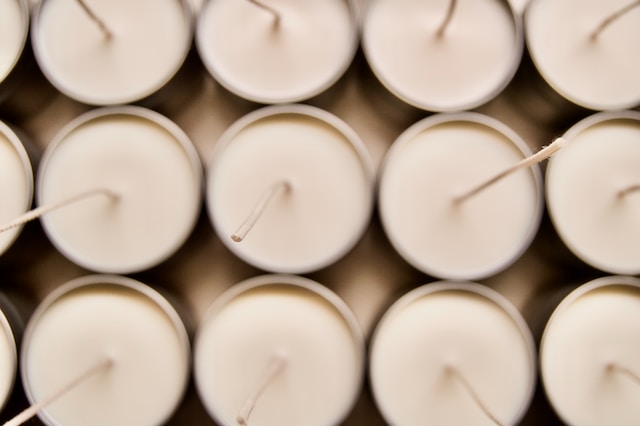Beeswax is a natural wax produced by honeybees while candle wax can be made from different types of materials such as paraffin, soy, or palm. Beeswax produce a brighter flame that emits negative ions which help purify the air and remove toxins.
What is beeswax?
(Photo by Bee Naturalles on Unsplash )

Beeswax is a natural wax produced by honeybees. It’s made from the secretion of glands on the underside of their abdomen. The bees collect nectar and pollen from flowers, then use enzymes in their stomach to convert it into beeswax.
The color of beeswax ranges from pale yellow to dark brown, depending on factors such as the age of the bee and its diet. Beeswax has a distinctively sweet smell that varies according to purity.
One unique aspect of beeswax is that it contains over 300 different compounds, including long-chain hydrocarbons, esters, and fatty acids. These chemical properties make it an ideal ingredient for cosmetic products like lip balms and lotions.
In addition to its beauty benefits, beeswax also has several health benefits. For example, when burned in candles or used in aromatherapy diffusers, it can purify the air by releasing negative ions that neutralize pollutants.
Beeswax is a versatile substance with many uses beyond just candle making!
What is candle wax?
(Photo by Kayla Warner on Unsplash )

Candle wax is the main ingredient used in candle making. It can be made from several different materials, including petroleum-based paraffin wax and natural plant- or animal-based waxes such as soy wax, palm wax, and beeswax.
Paraffin wax is the most commonly used type of candle wax due to its affordability and availability. However, it has been criticized for being derived from non-renewable resources and potentially releasing harmful chemicals when burned.
Natural waxes like soy wax are a popular alternative to paraffin because they are renewable and biodegradable. Soy candles also tend to burn cleaner with less soot than traditional paraffin candles.
Palm wax is another eco-friendly option that comes from sustainable sources. It has a unique crystalline structure that gives candles a beautiful texture when melted.
Each type has its own unique characteristics that can affect factors such as burn time, fragrance throw, color retention, cost-effectiveness, sustainability, and overall performance.
Beeswax Vs. Candle wax – Key differences
Beeswax and candle wax are two types of waxes that are commonly used in various applications. Although they may seem similar, there are several differences between them.
One key difference is their origin. Beeswax comes from the honeycomb of bees while candle wax can be made from different sources such as paraffin, soy, or palm. Another difference lies in their composition. Beeswax contains natural oils and fragrances that give it a distinct aroma while candle wax may contain additives to enhance its scent.
When it comes to melting point, beeswax has a higher melting point than most candle waxes which can make it more difficult to work with when making candles. Additionally, beeswax burns cleaner without producing harmful toxins unlike some types of candle waxes.
In terms of cost, beeswax is generally more expensive than traditional paraffin-based candles due to its natural sourcing and production process. However, many people prefer using beeswax for its eco-friendliness and natural properties.
Ultimately, the choice between beeswax and candle wax depends on personal preference and specific needs for individual projects or purposes.
How to choose the right type of wax for your needs
Choosing the right type of wax for your needs is essential when it comes to candle making. There are various types of wax available in the market, and each has its own unique properties that suit different needs.
Firstly, consider your desired outcome. Do you want a long-lasting, slow-burning candle or a quick-burning one with an intense fragrance? If you’re looking for longevity, then beeswax candles are the way to go as they burn 2-5 times longer than other waxes.
Secondly, consider the color and appearance you desire in your finished product. If you prefer natural colors without added dyes or pigments, then beeswax is perfect as it has an all-natural golden hue. On the other hand, if you want bright colored candles with endless possibilities for customization then soy wax is more suitable.
Think about environmental factors such as sustainability and eco-friendliness. Beeswax is sustainable and renewable while paraffin wax is derived from petroleum which can be harmful to both health and environment.
Choosing between beeswax vs candle wax depends on what works best for your specific needs; always take into consideration factors like longevity, aesthetics and environmental impact before deciding on which type of wax to use.
Can beeswax be used as candle wax?
Beeswax is a natural wax that has been used in candle making for centuries. But can it be used as candle wax? The answer is yes! Beeswax candles have become increasingly popular in recent years due to their natural and eco-friendly properties.
When using beeswax as candle wax, it’s important to note that the process may differ slightly from traditional candle making techniques. Beeswax has a higher melting point than other types of wax, so it requires more heat and attention during the melting process.
Another thing to keep in mind when using beeswax as candle wax is its unique scent. Unlike traditional candle waxes that are often chemically scented or unscented, beeswax has a sweet and subtle honey-like fragrance. This can be great for those who prefer natural scents in their candles.
One advantage of using beeswax as candle wax is its clean burning properties. Beeswax emits negative ions when burned which helps purify the air by neutralizing pollutants such as dust, mold, and allergens.
While there may be some differences in the process of using beeswax compared to traditional candle waxes, it can definitely be used successfully as a natural alternative for those looking for an eco-friendly option with unique benefits.
Which wax is better for candle making?
When it comes to candle making, the type of wax used plays a crucial role in determining the quality and performance of the finished product. The two most popular types of wax for candle making are beeswax and paraffin wax.
Beeswax is considered a premium option due to its natural origins and unique characteristics. It burns cleanly and emits a warm, honey-like fragrance that appeals to many people. However, beeswax can be more expensive than other waxes on the market.
On the other hand, paraffin wax is widely available and affordable, making it a popular choice among candle makers who prioritize cost-effectiveness over all else. It also holds color well and has a long shelf life.
Soy wax is another alternative that has gained popularity in recent years due to its sustainable nature as it’s made from soybean oil. Soy candles burn longer than paraffin candles but are not as fragrant or effective at holding color compared to beeswax or paraffin.
Ultimately, choosing which wax is best for your candles depends on factors such as personal preference, budget constraints, desired scent throw/fragrance profile,and sustainability values you want incorporated into your brand’s ethos.
What are the advantages and disadvantages of beeswax candles?
Beeswax candles have been used for centuries for their natural and eco-friendly properties. They are made from the wax produced by honeybees and offer numerous benefits over traditional paraffin candles.
One of the biggest advantages of using beeswax candles is that they are clean-burning, meaning they do not emit harmful toxins or chemicals into the air when burned. This makes them a great option for those with allergies or respiratory issues.
In addition to being non-toxic, beeswax candles also emit a pleasant, natural aroma when burned. This scent is said to have therapeutic properties which can help reduce stress and anxiety.
However, there are some disadvantages to using beeswax candles as well. One such disadvantage is cost – beeswax tends to be more expensive than other types of candle wax due to its purity and scarcity.
Another potential downside is that beeswax candles tend to burn slower than other types of candle wax, which may require more frequent trimming of the wick.
While there are both pros and cons to using beeswax candles, many people find that their unique qualities make them an excellent choice for enhancing ambiance in any environment without harming our planet’s health.
Featured Image By – Kelly Sikkema on Unsplash








